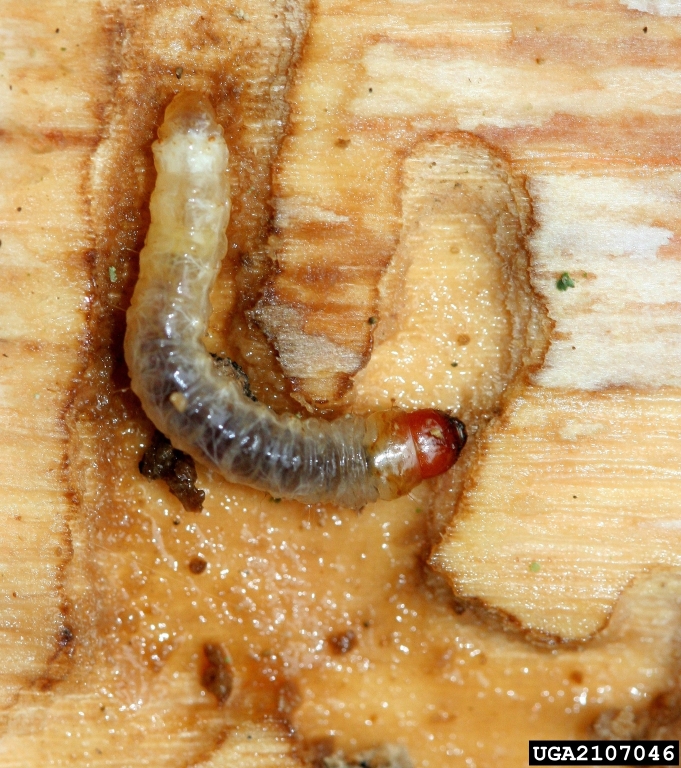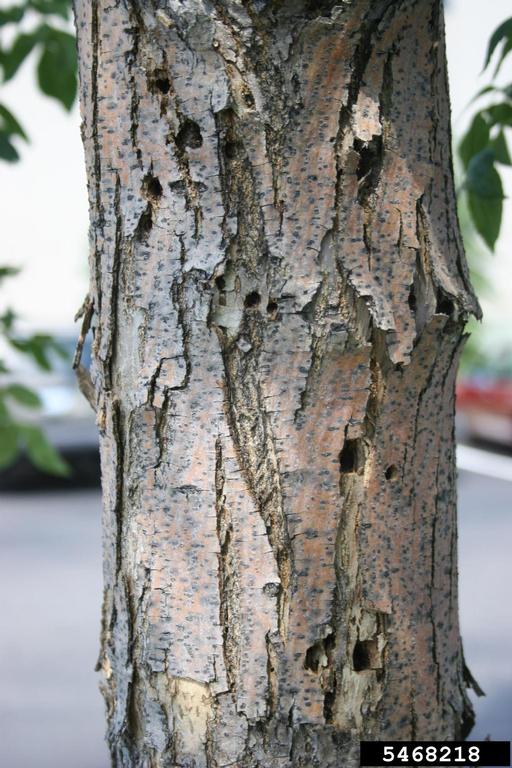Lilac borer is a pest that may weaken shrubs over time
Lilac borer is a mysterious pest that weakens lilacs and ash trees.

The lilac borer (Podosesia syringae), also called lilac-ash borer, is a clearwing moth (Photo 1) with a single generation per year whose larvae bore within the trunks of lilac and ash. Wood-boring larvae live beneath trunks for most of the year and damage the internal structures of trees and shrubs. They cause damage while creating tunnels and feeding in wood (Photo 2). Adults emerge in May or June and lay eggs shortly after mating.
The lilac borer adult’s period of activity peaks between 150 – 315 growing degree days at a base temperature of 50 degrees Fahrenheit. Adults are about 1 inch long with a wingspan of 1.5 inches. After hatching into larvae, they stay within the wood until the following season.
The borer is hard to detect, as the adult life stage is the only one that is active outside of branches and the trunk; it is only found for a few weeks. Unlike most moths, lilac borers fly during the daytime. While this insect is native to the Eastern USA and Canada, there is minimal recent research on this insect pest in the Midwest.

Signs of damage
Trees and shrubs affected by the lilac borer will have exit holes that form after the larvae emerge into adults (Photo 3). There may also be a small amount of sawdust at the base of trees when lilac borer populations are high. Plants will not die right away from lilac borer attack but will experience gradual decline that does not appear to be attributed to an obvious cause.

If your lilac is struggling due to an unknown reason, check near the lower 1-3 feet of the plant for evidence of larvae exit holes to determine if lilac borer is a contributing factor. Moderately affected lilacs can be pruned following the guidelines of renewal pruning. This involves removing a third of older stems to the ground level as well as weakened branches in the first year. Subsequently, continue in years two and three by cutting another third. After a season, the shrub will be reinvigorated with newer, healthier stems. If many new stems emerge, select only a few designated ones to promote larger stems and remove the others. Shrubs with severe damage should be removed and disposed of during the fall months.
Ash trees affected by the lilac borer will show symptoms of canopy loss. Larval damage in the bark can cause cracking or breaking. These weakened branches need to be pruned off.
Chemical control is possible if timed to match the period when the larvae have just hatched, and the adults are laying eggs. Insecticides with the active ingredients of bifenthrin, permethrin or carbaryl can be applied to the trunk and branches of lilac or ash with known borer issues.
Lilac issues in Michigan

Every year, Mackinac Island hosts a Lilac Festival to celebrate the prominence of this plant on the Island (Photo 4). To monitor the health of the plants as well as provide continued care, Michigan State University Extension is partnering with the Mackinac Island Tourism Bureau to help develop a plan for lilac borer activity. Initial steps will involve monitoring for the presence of this insect pest. Over 50 pheromone monitoring traps will be present in May and June to identify how widespread lilac borer populations are and to learn more about the timing of lilac borer emergence.
Ash populations in much of the Lower Peninsula have been previously decimated by the emerald ash borer, and it is less common to find ash trees with damage from lilac-ash borer in southern and central Michigan. The lilac borer is found in slightly higher populations in the Upper Peninsula and has been known to lay its eggs in white ash.



 Print
Print Email
Email